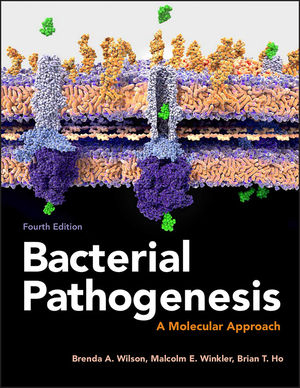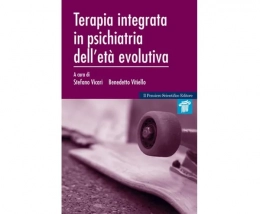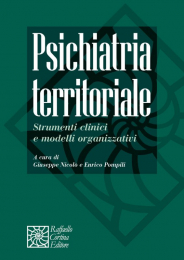Non ci sono recensioni
DA SCONTARE
This highly anticipated update of the acclaimed textbook draws on the latest research to give students the knowledge and tools to explore the mechanisms by which bacterial pathogens cause infections in humans and animals. Written in an approachable and engaging style, the book uses illustrative examples and thought-provoking exercises to inspire students with the potential excitement and fun of scientific discovery.
Completely revised and updated, and for the first time in stunning full-color, Bacterial Pathogenesis: A Molecular Approach, Fourth Edition, builds on the core principles and foundations of its predecessors while expanding into new concepts, key findings, and cutting-edge research, including new developments in the areas of the microbiome and CRISPR as well as the growing challenges of antimicrobial resistance. All-new detailed illustrations help students clearly understand important concepts and mechanisms of the complex interplay between bacterial pathogens and their hosts. Study questions at the end of each chapter challenge students to delve more deeply into the topics covered, and hone their skills in reading, interpreting, and analyzing data, as well as devising their own experiments. A detailed glossary defines and expands on key terms highlighted throughout the book. Written for advanced undergraduate, graduate, and professional students in microbiology, bacteriology, and pathogenesis, this text is a must-have for anyone looking for a greater understanding of virulence mechanisms across the breadth of bacterial pathogens.
Preface xvii
In Memoriam xix
About the Authors xxi
Chapter 1 The Power of Bacteria 2
Why Are Bacteria So Much in the Public Health Spotlight Nowadays? 3
Bacteria, a Formidable Ancient Life Form 4
Pressing Current Infectious Disease Issues 6
Emerging and Reemerging Infectious Diseases 6
Foodborne and Waterborne Infections 7
Modern Medicine as a Source of New Diseases 8
Postsurgical and Other Wound Infections 9
Bioterrorism 10
A New Respect for Prevention 10
Surveillance: An Early Warning System 11
Making Hospitals Safe for Patients 12
And Now for Some Good News: You’ve Got a Bacterial Infection! 12
The Helicobacter pylori Revolution 12
The Aftermath 13
Microbiota Shift Diseases 13
A Brave New World of Pathogenesis Research 14
The New Age of Genomics 16
Insights into Pathogen Evolution 17
Modeling the Host-Pathogen Interaction in Experimental Animals 17
Correlation Studies 18
Selected Readings 18
Questions 20
Chapter 2 Skin and Mucosa: The First Lines of Defense against Bacterial Infections 22
The Best Defense: Avoid, Reduce, and Prevent Exposure! 23
Barriers: Skin and Mucosal Membranes 24
The Layers of Cells That Protect the Body 24
Normal Microbiota of the Skin and Mucosa 27
Defenses of the Skin 31
Defenses of Mucosal Surfaces 32
Special Defenses of the Gastrointestinal Tract 34
Special Defenses of the Urogenital Tract 36
Special Defenses of the Respiratory Tract 36
Immune Defenses of the Skin and Mucosa 37
Models for Studying Breaches of Barrier Defenses 38
Selected Readings 39
Questions 39
Chapter 3 The Innate Immune System: Always on Guard 40
Triggering Innate Immune Defenses 41
Innate Immune Cells That Defend Blood and Tissue 42
Neutrophils (PMNs) 42
Monocytes, Macrophages, and Dendritic Cells (DCs) 42
Granulocytes: Basophils, Mast Cells, and Eosinophils 47
Transmigration—How Do Phagocytes Know When and Where to Go? 47
Natural Killer (NK) Cells 48
The Lymphatic System 50
How Phagocytes Recognize and Respond to Bacteria 50
How Phagocytes Kill Bacteria 54
Oxidative Burst in Phagolysosomes 54
Autophagy—Another Pathway for the Killing of Intracellular Pathogens 56
The Complement Cascade 57
Complement Proteins 57
Overview of Complement Pathways and Their Function 58
Steps in Complement Activation 60
Controlling Complement Activation 62
Cytokines and Chemokines—Mediators of Immune Responses 63
Roles of Cytokines and Chemokines in Directing Innate Immune Responses 63
Inflammation and Collateral Damage 65
Septic Shock: The Dark Side of the Innate Defenses 66
Other Innate Defenses of the Body—Nutritional Immunity 69
Selected Readings 70
Questions 70
Chapter 4 The Adaptive Defenses: Antibodies and Cytotoxic T Cells 72
The Specialists: Adapting to a Particular Pathogen Challenge 73
B Cells: Producers of Antibodies 74
The Humoral (Antibody) Immune Response 74
Characteristics of Antibodies and Their Diverse Roles in Preventing Infection 74
Serum Antibodies 76
Secretory Antibodies: Antibodies That Protect Mucosal Surfaces 78
Pathogen and Toxin Neutralization by Antibodies 79
Affinity and Avidity 80
Cytotoxic T Cells, Also Known as Cytotoxic T Lymphocytes (CTLs) 81
Cytotoxic T Lymphocytes: Critical Defense against Intracellular Pathogens 81
Antigen Presentation to the Immune System 82
Processing of Protein Antigens by Dendritic Cells 82
Interaction between APCs and T Cells: The T-Cell-Dependent Response 84
Th-(Th1/Th2/Th17)-Cell-Mediated Immunity 86
Production of Antibodies by B Cells 87
Links between the Innate and Adaptive Defense Systems 88
T-Cell-Independent Antibody Responses 89
Mucosal Immunity: IgA/sIgA Antibodies 89
Development of the Adaptive Immune System from Infancy to Adulthood 92
Adaptive Defense Systems in Nonmammals 93
The Dark Side of the Adaptive Defenses: Autoimmune Disease 93
Selected Readings 94
Questions 94
Solving Problems in Bacterial Pathogenesis 95
Chapter 5 The Microbiota of the Human Body: Microbiomes and Beyond 98
Importance of the Normal Resident Microbial Populations (Microbiota) of the Human Body 99
Characterization of the Body’s Microbiota 100
Taking a Microbial Census by Using Microbial rRNA Gene Sequence Analysis 101
Characterizing Microbiomes by Using Metagenomic Analysis 115
Beyond the Metagenome 117
Overview of the Human Microbiota 123
Skin Microbiota 124
Oropharyngeal Microbiota 125
Microbiota of the Small Intestine and Colon 125
Microbiota of the Vaginal Tract 128
The Other Microbiota: The Forgotten Eukaryotes 130
Selected Readings 130
Questions 131
Solving Problems in Bacterial Pathogenesis 133
Chapter 6 Microbes and Disease: Establishing a Connection 134
History and Relevance of Koch’s Postulates 136
Early Germ Theory 136
Koch’s Postulates: A Set of Criteria Used to Establish a Microbe-Disease Connection 137
Challenges to Satisfying Koch’s Postulates 138
Easier Said than Done . . . 138
The First Postulate: Association of the Microbe with Lesions of the Disease 139
The Second Postulate: Isolating the Bacterium in Pure Culture 140
The Third Postulate: Showing that the Isolated Bacterium Causes Disease Experimentally in Humans or Animals 141
The Fourth Postulate: Reisolating the Bacterium from the Intentionally Infected Animal 143
Modern Alternatives to Satisfy Koch’s Postulates 143
Detecting the Presence of the Pathogen Only in Diseased Tissues 143
Eliminate the Pathogen and Prevent or Cure the Disease 144
Comparative Infectious Disease Causation 147
The Microbiota Shift Disease Problem 147
Koch’s Postulates and Pathogenic Microbial Communities 147
Keystone Pathogens and Microbial Shift Diseases 147
Molecular Koch’s Postulates 149
Concepts of Disease 150
Varieties of Human-Microbe Interactions 150
Views of the Human-Microbe Interaction 150
Virulence as a Complex Phenomenon 152
Selected Readings 152
Questions 153
Solving Problems in Bacterial Pathogenesis 153
Chapter 7 Mechanisms of Genetic Modification and Exchange: Role in Pathogen Evolution 156
Adapt or Perish 158
Acquiring New Virulence Traits by Horizontal Gene Transfer 158
Mechanisms of Genetic Change and Diversification 158
Spontaneous Mutation 158
Phase Variation 159
Antigenic Variation 161
Horizontal Gene Transfer: Mobile Genetic Elements 162
Natural Transformation 162
Conjugation: Plasmids and Transposons 165
Phage Transduction 171
Control of Horizontal Gene Transfer 171
Toxin-Antitoxin Systems—Retaining the Goods 171
Restriction-Modification Systems—Bacterial Innate Immunity from Foreign DNA 173
CRISPR-Cas Systems—Bacterial Adaptive Immunity from Foreign DNA 173
Type 6 Secretion Systems—Bacterial Defense Against Conjugation 174
Pathogenicity Islands and Pathogen Evolution 174
Properties of Pathogenicity Islands 174
Pathogen Evolution in Quantum Leaps 177
Selected Readings 178
Questions 179
Solving Problems in Bacterial Pathogenesis 179
Chapter 8 Identification of Virulence Factors: Measuring Infectivity and Virulence 182
How Does One Experimentally Measure Virulence and Satisfy Koch’s Postulates? 183
Animal Models of Infection 184
Human Volunteers 184
Nonhuman Animal Models 186
Measuring Bacterial Infection in Animal Models 188
Ethical Considerations 188
Animal Model Basics 188
Survival Curve Analysis and Biophotonic Imaging 189
ID50 and LD50 Values 190
Competition Assays 191
Tissue Culture and Organ Culture Models 192
Tissue Culture Models 192
Gentamicin Protection Assay for Cell Adhesion and Invasion 193
Plaque Assay for Intracellular Survival and Cell-to-Cell Spread 195
Fluorescence Microscopy Techniques for Assessing Effects of Pathogens on Host Cells 196
Organ Culture Models 196
The Continuing Need for Reliable and Plentiful Information about Disease Pathology 197
Selected Readings 198
Questions 199
Solving Problems in Bacterial Pathogenesis 200
Chapter 9 Identification of Virulence Factors: Molecular Approaches for Bacterial Factors 202
Finding a Needle in a Haystack 204
Biochemical Approaches 204
Isolation and Purification of Toxic Factors 204
Molecular Genetic Approaches 208
Screening Using Recombinant Genes 208
Reporter Fusions 208
Mutagenesis Screening 210
Genome-wide Sequencing Approaches for Identifying Virulence Genes 214
Tn-Seq Technology to Identify In Vivo-Expressed Genes 214
RNA-Seq Technology to Identify In Vivo-Expressed Genes 216
Comparative Genomic Sequence Analysis for Identifying Virulence Genes 217
Proteomics Approaches for Identifying Virulence Factors 218
Protein Microarrays (Proteoarrays) 218
In Vivo-Induced Antigen Technology (IVIAT) 218
The Importance of Understanding Bacterial Physiology 219
Selected Readings 222
Questions 223
Solving Problems in Bacterial Pathogenesis 223
Chapter 10 Identification of Virulence Factors: Molecular Approaches for Host Factors 226
Comparative Approaches to Identify Host Factors Required for Infection 227
Transgenic Animal Models 228
In vivo Imaging of Animals during Infection 231
Systems Genetics: Comparative Genomics of the Host Response 231
Screening Approaches to Identify Host Factors Required for Infection 235
Genome-Wide Screening 235
Host Response Profiling to Identify Host Factors Required for Infection 240
Transcriptomics 240
Proteomics 243
Metabolomics 246
The Promise and the Caution 247
Selected Readings 248
Questions 249
Solving Problems in Bacterial Pathogenesis 249
Chapter 11 Bacterial Strategies for Colonization and Survival in the Host 254
What Does Not Kill You Makes You Stronger—Or, a Better Pathogen 255
Preinfection 258
Survival in the External Environment 258
Biofilms 258
Motility and Chemotaxis 260
Colonization of Host Surfaces 263
Penetrating Intact Skin 263
Penetrating the Mucin Layer 263
Evading the Host’s Innate Immunity 264
Nutrient and Iron Acquisition Mechanisms 265
Adherence 268
Evading the Host Immune Response 275
Avoiding Complement and Phagocytosis 277
Invasion and Uptake by Host Cells 280
Surviving Phagocytosis 281
Cell-to-Cell Spread 286
Tissue Penetration and Dissemination 288
Beyond Virulence Factors 288
Selected Readings 289
Questions 290
Solving Problems in Bacterial Pathogenesis 290
Special Global Perspective Problem: Integrating Concepts in Pathogenesis 291
Chapter 12 Toxins and Other Toxic Virulence Factors 294
Bacterial Toxins 295
Transparent Mechanisms, Exciting Applications, Mysterious Purposes 295
Toxin Characteristics and Nomenclature 300
Nonprotein Toxins 302
Peptide and Protein Exotoxins 304
Toxic Effector Proteins of Specialized Secretion Systems 312
Examples of Toxin-Mediated Diseases 313
Diphtheria Toxin 313
Clostridial Neurotoxins 319
Cholera Toxin 323
Toxin-Based Therapeutics and Research Tools 327
Immunotoxins 327
Selected Readings 329
Questions 330
Solving Problems in Bacterial Pathogenesis 331
Chapter 13 Delivery of Virulence Factors 334
Bacterial Secretion Systems and Virulence 335
Common Secretory Systems 336
The General Secretory (Sec) System 336
The Accessory Secretory (Sec) System 336
The Cotranslational Signal-Recognition Particle (SRP) System 336
The Twin-Arginine Transport (TAT) System 337
Secretion Systems Specific to Gram-Negative Bacteria 338
Sec-Dependent Secretion Systems 338
Sec-Independent Secretion Systems 341
Specialized Secretion Systems Specific to Gram-Positive Bacteria 350
General Secretory Transporter Systems in Gram-Positive Bacteria 350
Cytolysin-Mediated Translocation (CMT) in S. pyogenes (Group A Strep) 351
Type 7 Secretion System (T7SS) 352
Selected Readings 353
Questions 354
Solving Problems in Bacterial Pathogenesis 355
Chapter 14 Virulence Regulation 360
Virulence Gene Regulation 361
Mechanisms of Regulation 361
Operons, Regulons, and Global Regulators 362
Activators and Repressors 362
Two-Component Regulatory Systems 364
Sigma Factors 368
Transcriptional Terminators and Antiterminators 369
Regulation of Translation Initiation 372
Regulatory Small RNAs 372
Bacterial Chromatin 375
Responding to Environmental Signals 376
Phase Variation and Bistable Switches 376
Hypermutability, Intragenomic Recombination, and Positive Selection 377
Coordinate Virulence Regulation 377
Quorum Sensing 378
Chemotaxis 387
Selected Readings 389
Questions 389
Solving Problems in Bacterial Pathogenesis 390
Special Global Perspective Problems: Integrating Concepts in Pathogenesis 395
Chapter 15 Antimicrobial Compounds and Their Targets 400
Antimicrobial Compounds: The Safety Net of Modern Medicine 401
The Importance of Antimicrobial Compounds 401
Avoiding, Reducing, and Preventing Exposure 402
Killing versus Inhibiting Growth 404
Tests Used to Assess Antibiotics 404
Antiseptics and Disinfectants 405
Antibiotics 407
Characteristics of Antibiotics 407
The Process of Antibiotic Discovery 409
The Economics of Antibiotic Discovery 413
Mechanisms of Antibiotic Action 416
Targets of Antibiotic Action 416
Cell Wall Synthesis Inhibitors 417
Protein Synthesis Inhibitors 422
Antibiotics That Target DNA and RNA Synthesis 425
Inhibitors of Tetrahydrofolate Biosynthesis 429
The Newest Antibiotics 429
The Newest Antibiotic Targets 430
Strategies for Enhancing Antibiotic Efficacy 431
The Continuing Challenge 432
Selected Readings 433
Questions 434
Solving Problems in Bacterial Pathogenesis 435
Chapter 16 Antibiotic Resistance 436
The Dawning of Awareness—Uh, We Have a Problem! 437
How Did We Get to Where We Are? 438
And Now the Really Scary Part . . . 440
Emergence and Challenge of Multidrug Resistance (MDR) 440
Multiple Resistance and Genetic Linkage 441
Next-Generation MDR Pathogens: The “Superbugs”! 441
Mechanisms of Antibiotic Resistance 444
Overview of Resistance Mechanisms 444
Resistance to Antiseptics and Disinfectants 444
Limiting Access of the Antibiotic 445
Enzymatic Inactivation of the Antibiotic 446
Modification or Protection of the Antibiotic Target 451
Failure to Activate an Antibiotic 453
Regulation of Resistance Genes 454
Antibiotic Tolerance and Persister Cells 457
Antibiotic Tolerance 457
Persistence 459
Toxin-Antitoxin Systems 459
Horizontal Gene Transfer (HGT) of Resistance Genes 461
Propagating and Maintaining Antibiotic Resistance through Selective Pressure and Changes in Fitness 463
Will We Return to the Pre-Antibiotic Era? 464
Returning to Status Quo or Moving Forward? 464
The Hunt for Alternative Approaches to Antibiotics 466
Selected Readings 468
Questions 469
Solving Problems in Bacterial Pathogenesis 470
Special Global Perspective Problems: Integrating Concepts in Pathogenesis 470
Chapter 17 Vaccination: A Critical Component of the Modern Medical Armamentarium 476
Vaccines: A Major Health Care Bargain 477
What Makes an Ideal Vaccine? 479
Immunization Programs 480
Barriers to Implementation and Success of Immunization Programs 483
The Antivaccination Movement 484
Vaccine Success Stories 485
Subunit Vaccines 485
Conjugate Vaccines 490
Vaccine “Less-than-Success” Stories 492
A New Age of Vaccine Development: Making Vaccines Better 494
Approaches to Enhancing Immunogenicity 494
Adjuvants 494
Programming Adaptive Immunity 496
Targeting Mucosal Immunity 500
Storage of Vaccines—Strategies to Increase Shelf Life 504
Passive Immunization 504
Selected Readings 505
Questions 505
Solving Problems in Bacterial Pathogenesis 508
Special Global Perspective Problems: Integrating Concepts in Pathogenesis 510
Chapter 18 The Gram-Positive Opportunistic Pathogens 514
What Is an Opportunist? 515
Characteristics of Gram-Positive Opportunists 516
Notable Gram-Positive Opportunists 516
Staphylococcus aureus—Commensal Ready for a Fight 516
Staphylococcus epidermidis—Accidental Pathogen 524
Streptococcus pneumoniae—“Captain of All the Men of Death” 527
Clostridium difficile—True Opportunist 534
Other Gram-Positive Opportunists 542
Selected Readings 543
Questions 544
Solving Problems in Bacterial Pathogenesis 544
Chapter 19 The Gram-Negative Opportunistic Pathogens 548
Jumping Over the (Cell) Wall: Gram-Negative Bacteria Can Be Opportunistic Pathogens Too! 549
Common Traits of Gram-Negative Opportunists 549
The Dark Side of Some Residents of the Human Body 550
The Ever-Changing Face of E. coli 550
Klebsiella pneumoniae Nosocomial Infections 554
Bacteroides fragilis—The Bad Sheep of the Family 555
Porphyromonas gingivalis—A Keystone Pathogen 557
Environmental Inhabitants Weigh in as Opportunists 558
Pseudomonas aeruginosa—A Versatile Opportunist of the Highest Order 558
Burkholderia cepacia Complex—P. aeruginosa’s Evil Twin 565
Acinetobacter baumannii—A Deadly Threat Emerges from the Iraq War 565
Don’t Forget the Arthropods! 567
Ehrlichia spp. 567
Selected Readings 568
Questions 569
Solving Problems in Bacterial Pathogenesis 569
Special Global Perspective Problems: Integrating Concepts in Pathogenesis 570
Chapter 20 The Changing Roles of Microbiologists in an Age of Bioterrorism and Emerging Diseases 574
When Microbiologists Are Called to the Front Line 575
Tracking Down a Bioterrorist 576
Unintentional or Deliberate? 577
Timing 579
Tracing the Source 579
Lessons Learned 579
The “Top Four” Bioterror Agents 582
Bacillus anthracis Spores 582
Smallpox 583
Yersinia pestis 583
Botulinum Neurotoxin 584
What If Bioterrorists Hit Us with Something Completely New? 585
Biosecurity in a Complex, Dynamic, and Ever-Changing World 585
Food Safety and Biosecurity 586
The Case for Food Irradiation 587
The Future of Biosecurity 589
Selected Readings 589
Questions 590
Solving Problems in Bacterial Pathogenesis 591
Glossary 593
Index 661




